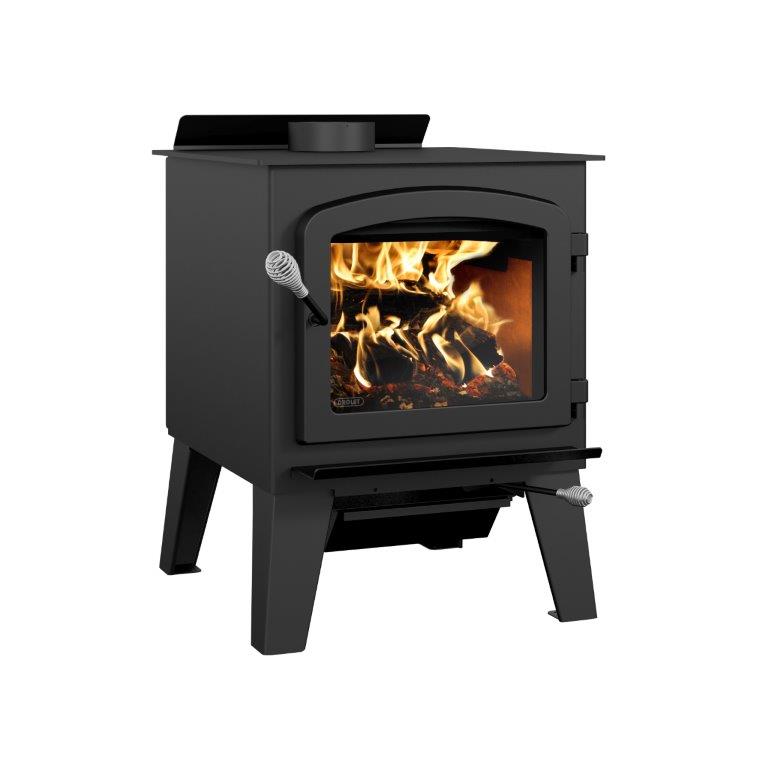Looking for input on a stove upgrade. I live in a 1930s 1,050 square foot log cabin in northern New England. Place came with a 1970s-era Shenandoah R-77 bimetal woodstove--definitely an inefficient stove but at least a beast that can heat during single digit and sub-zero cold. After a few winters babying the Shenandoah (always a balancing act between clamping the air intake down for a long overnight burn while not smoldering it into backpuffing range), I'm looking to enter the twenty-first century with a new stove.
A local chimney sweep recommended I look at getting Lowe's Summers Heat 50-SHW06L stove if I don't want to spend a lot of money. My current flue setup is about 1 foot vertical out of the top of the Shenandoah, 3 feet horizontal into an exterior stone chimney, and then 13 feet vertical to the cap. The entire length is a 6 inch metal liner that I'm told was installed 2 years ago, with some fiberglass wrapping around the top 2 feet of the liner to create a bit of a plug at the top (hopefully to create some air insulation between the liner and stone chimney). From ground to top of flue is 18 feet. (i'll attach a diagram)
I'm just looking for some feedback from folks with more woodstove experiance than myself about this hypothetical setup with a Summers Heat. Anyone with experience specific to the Summers Heat 50-SHW06L model would be appreciated--especially how feasible it is to run it at the 400 degree range for sustained periods, as opposed to 600. My worry is that I'll run myself out of the place if its at 600 when the outside temp hasn't plunged below 20 degrees.
I've also heard some complaints on forums about the Summers Heat not drafting well, which gives me pause with my setup as my heights/lengths aren't that long (though the Summers heat manual says it requires minimum of 15 feet chimney height, and I'm at 18+ feet from ground to the cap, though the actual vertical length of the flue is below that). Though it would look odd, I could feasibly add 1 to 2 feet of flue to the top, above the stone chimney height.
Beyond that, any observations or input that I might be missing would be appreciated!
A local chimney sweep recommended I look at getting Lowe's Summers Heat 50-SHW06L stove if I don't want to spend a lot of money. My current flue setup is about 1 foot vertical out of the top of the Shenandoah, 3 feet horizontal into an exterior stone chimney, and then 13 feet vertical to the cap. The entire length is a 6 inch metal liner that I'm told was installed 2 years ago, with some fiberglass wrapping around the top 2 feet of the liner to create a bit of a plug at the top (hopefully to create some air insulation between the liner and stone chimney). From ground to top of flue is 18 feet. (i'll attach a diagram)
I'm just looking for some feedback from folks with more woodstove experiance than myself about this hypothetical setup with a Summers Heat. Anyone with experience specific to the Summers Heat 50-SHW06L model would be appreciated--especially how feasible it is to run it at the 400 degree range for sustained periods, as opposed to 600. My worry is that I'll run myself out of the place if its at 600 when the outside temp hasn't plunged below 20 degrees.
I've also heard some complaints on forums about the Summers Heat not drafting well, which gives me pause with my setup as my heights/lengths aren't that long (though the Summers heat manual says it requires minimum of 15 feet chimney height, and I'm at 18+ feet from ground to the cap, though the actual vertical length of the flue is below that). Though it would look odd, I could feasibly add 1 to 2 feet of flue to the top, above the stone chimney height.
Beyond that, any observations or input that I might be missing would be appreciated!
Attachments
Last edited:


![[Hearth.com] Upgrade to Summers Heat -- Looking for input!](/talk/data/attachments/266/266909-17d07ecd5fdc161c792cc5a5b6deeff2.jpg?hash=bUJsFHgvjw)
![[Hearth.com] Upgrade to Summers Heat -- Looking for input!](/talk/data/attachments/266/266910-900885d204c4b49d535e59a47ec5ca52.jpg?hash=0vTMjtc5Xj)
![[Hearth.com] Upgrade to Summers Heat -- Looking for input!](/talk/data/attachments/266/266911-98f4e348b72470f922ca4523231be73c.jpg?hash=5TJMue04IL)
![[Hearth.com] Upgrade to Summers Heat -- Looking for input!](/talk/data/attachments/266/266913-575fd4074b33c10c8fbc024c0aae88d4.jpg?hash=qfNAxGpUgc)
![[Hearth.com] Upgrade to Summers Heat -- Looking for input!](/talk/data/attachments/266/266946-8729c551106f60a0ad86944813a4bf84.jpg?hash=btPldCkVuN)
